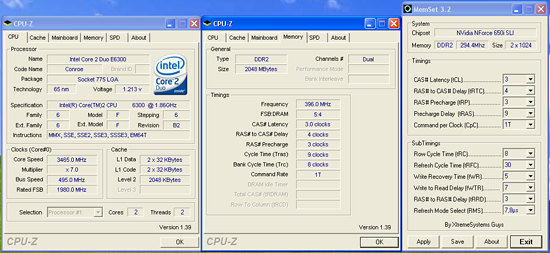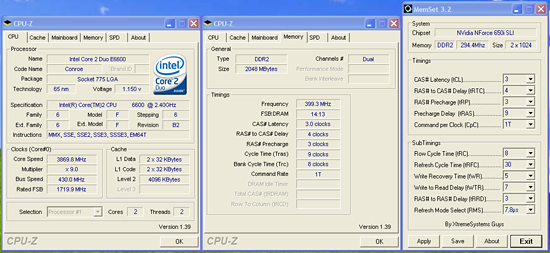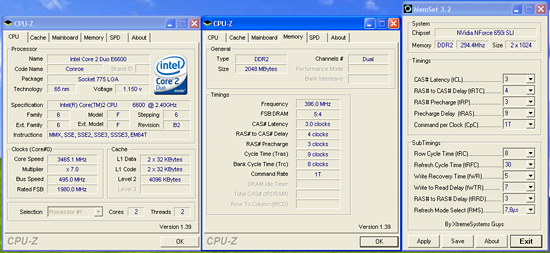ASUS P5N32-E SLI Plus: NVIDIA's 650i goes Dual x16
by Gary Key on April 2, 2007 3:30 AM EST- Posted in
- Motherboards
Overclocking - E6300
We were able to reach a final benchmark stable setting of 7x495 FSB resulting in a clock speed of 3465MHz. We were able to run our OCZ Flex PC2-9200, OCZ Flex PC2-6400, and our Corsair PC2-8888 at the reported timings with a 1T Command Rate enabled with 2.250V. When overclocking we were able to run our standard OCZ Flex PC2-6400 at 1T command rates with very aggressive sub-timings. Vdroop was very good on this board during E6300 overclocking with an average drop of .02V during load testing with our E6300.
Testing with our new OCZ Flex PC2-6400 CAS3 (standard memory installed) and G.Skill F2-6400CL4D-2GBHK modules based on ProMOS IC chips resulted in great success on this board. The OCZ Flex PC2-6400 was able to run up to DDR2-850 speeds with timings at 3-4-3-9 1T at 2.250V and the G.Skill F2-6400CL4D at 4-3-3-9 1T at 2.20V. The remaining memory timings are set to Auto as is standard in our testing and manually adjusting these timings resulted in increased stability while overclocking while minimally decreasing performance in certain games and applications that are memory sensitive. We did notice in 4GB testing that we had to change our OCZ Flex PC2-6400 CAS3 memory timings to 3-4-4-10 2T at 2.275V for stable 24/7 operation in a variety of applications.
Overclocking - E6600
After trying numerous voltages and memory timings we discovered our 9x430 FSB setting was the limit for both our board and CPU. This resulted in a final clock speed of 3869MHz at 1.4750V which is the limit for our Tuniq 120 air cooler. We did find the typical FSB hole around 416FSB but did not notice the same issues we had with the 680i LT SLI having several FSB ranges that were unusable. We were able to post and complete benchmark testing at 435FSB but could not pass dual Prime95 at that setting. Vdroop was very acceptable but not great during overclocking with an average drop of .03V ~ .04V during load testing with our E6600. We generally found that without decent airflow around the CPU and memory locations that our maximum FSB was near 408 with this configuration.
We dropped the multiplier on our E6600 to seven and were able to reach the same 495 FSB level as with the E6300. We were able to enter XP at 7x515 but the board was not stable, and we could complete all benchmarks at 7x510 except for dual Prime95. At first we thought the board was locked at 500FSB but once again we found FSB holes but this time they ranged from 502 to 516. We noticed in overclock testing that we were able to extract an 1133 memory speed at 5-5-4-15 2T timings at 2.20V with our OCZ Flex PC2-6400. This matches the 680i LT SLI speeds at slightly better timings although performance differences were minimal with sub-timings set the same. We dropped in our OCZ Flex PC2-9200 and Corsair PC2-9136 modules with both being able to reach DDR2-1275 but at 5-5-5-18 timings compared to the 5-5-4-12 2T timings at 2.30V on the 680i LT SLI board. Memory performance and stability was superb once the board was dialed in.
| ASUS P5N32-E SLI Plus Dual Core Overclocking |
|
| Processor: | Intel Core 2 Duo E6300 Dual Core, 1.86GHz, 2MB Unified Cache 1066FSB, 7x Multiplier |
| CPU Voltage: | 1.4500V (default 1.3250V) |
| NB Voltage: | 1.45V |
| 1.2V HTT Voltage: | 1.40V |
| SB Voltage: | 1.50V |
| CPU VTT: | 1.25V |
| Cooling: | Tuniq 120 Air Cooling |
| Power Supply: | OCZ ProXStream 1000W |
| Memory: | OCZ Flex XLC PC2-6400 (2x1GB) |
| Video Cards: | 1 x MSI 8800GTX |
| Hard Drive: | Western Digital 150GB 10, 000RPM SATA 16MB Buffer |
| Case: | Cooler Master CM Stacker 830 |
| Maximum OC: | 495x7 (3-4-3-9 1T, 792MHz, 2.250V), CPU 1.4500V 3465MHz (+86% FSB/CPU) |
| . | |
 |
| Click to enlarge |
We were able to reach a final benchmark stable setting of 7x495 FSB resulting in a clock speed of 3465MHz. We were able to run our OCZ Flex PC2-9200, OCZ Flex PC2-6400, and our Corsair PC2-8888 at the reported timings with a 1T Command Rate enabled with 2.250V. When overclocking we were able to run our standard OCZ Flex PC2-6400 at 1T command rates with very aggressive sub-timings. Vdroop was very good on this board during E6300 overclocking with an average drop of .02V during load testing with our E6300.
Testing with our new OCZ Flex PC2-6400 CAS3 (standard memory installed) and G.Skill F2-6400CL4D-2GBHK modules based on ProMOS IC chips resulted in great success on this board. The OCZ Flex PC2-6400 was able to run up to DDR2-850 speeds with timings at 3-4-3-9 1T at 2.250V and the G.Skill F2-6400CL4D at 4-3-3-9 1T at 2.20V. The remaining memory timings are set to Auto as is standard in our testing and manually adjusting these timings resulted in increased stability while overclocking while minimally decreasing performance in certain games and applications that are memory sensitive. We did notice in 4GB testing that we had to change our OCZ Flex PC2-6400 CAS3 memory timings to 3-4-4-10 2T at 2.275V for stable 24/7 operation in a variety of applications.
Overclocking - E6600
| ASUS P5N32-E SLI Plus Dual Core Overclocking |
|
| Processor: | Intel Core 2 Duo E6600 Dual Core, 2.4GHz, 4MB Unified Cache 1066FSB, 9x Multiplier |
| CPU Voltage: | 1.4750V / 1.4500 (default 1.3250V) |
| NB Voltage: | 1.45V |
| 1.2V HTT Voltage: | 1.45V |
| SB Voltage: | 1.50V |
| CPU VTT: | 1.35V / 1.30V |
| Cooling: | Tuniq 120 Air Cooling |
| Power Supply: | OCZ ProXStream 1000W |
| Memory: | OCZ Flex XLC PC2-6400 (2x1GB) |
| Video Cards: | 1 x MSI 8800GTX |
| Hard Drive: | Western Digital 150GB 10, 000RPM SATA 16MB Buffer |
| Case: | Cooler Master CM Stacker 830 |
| Maximum CPU OC: | 430x9 (3-4-3-9 1T, 799MHz, 2.25V), CPU 1.4750V 3869MHz (+61%) |
| Maximum FSB OC: | 495x7 (3-4-3-9 1T, 792MHz, 2.25V), CPU 1.4500V 3465MHz (+86% FSB) |
| . | |
 |
| Click to enlarge |
After trying numerous voltages and memory timings we discovered our 9x430 FSB setting was the limit for both our board and CPU. This resulted in a final clock speed of 3869MHz at 1.4750V which is the limit for our Tuniq 120 air cooler. We did find the typical FSB hole around 416FSB but did not notice the same issues we had with the 680i LT SLI having several FSB ranges that were unusable. We were able to post and complete benchmark testing at 435FSB but could not pass dual Prime95 at that setting. Vdroop was very acceptable but not great during overclocking with an average drop of .03V ~ .04V during load testing with our E6600. We generally found that without decent airflow around the CPU and memory locations that our maximum FSB was near 408 with this configuration.
 |
| Click to enlarge |
We dropped the multiplier on our E6600 to seven and were able to reach the same 495 FSB level as with the E6300. We were able to enter XP at 7x515 but the board was not stable, and we could complete all benchmarks at 7x510 except for dual Prime95. At first we thought the board was locked at 500FSB but once again we found FSB holes but this time they ranged from 502 to 516. We noticed in overclock testing that we were able to extract an 1133 memory speed at 5-5-4-15 2T timings at 2.20V with our OCZ Flex PC2-6400. This matches the 680i LT SLI speeds at slightly better timings although performance differences were minimal with sub-timings set the same. We dropped in our OCZ Flex PC2-9200 and Corsair PC2-9136 modules with both being able to reach DDR2-1275 but at 5-5-5-18 timings compared to the 5-5-4-12 2T timings at 2.30V on the 680i LT SLI board. Memory performance and stability was superb once the board was dialed in.










37 Comments
View All Comments
Spanki - Monday, April 2, 2007 - link
Nice review, but I must say that at worse it's misleading and at best it's potentially confusing regarding the memory timings used (in particular, the command-rate). I really liked seeing both 1T and 2T benchmark numbers, but the images would have been a lot better if the command-rate was listed for _every_ board tested (every line-item).In the absense of that, I have to assume that the rate was 2T for all other boards, unless specifically stated, but even that pattern wasn't followed on the first graphic. I guess this means that I'm casting a vote to see the 1T numbers/comparisons on all the boards (whether or not it makes a 'significant' difference) - if you threw out all the 1T results in this review, I think you get an overall different 'picture' of how well this board compares with the others.
JarredWalton - Monday, April 2, 2007 - link
I believe Gary is in the process of retesting boards with 1T where it works, and that will be part of an upcoming roundup. The problem is that until recently, the 680i boards were unable to support 1T at DDR2-800, and no other chipset has managed it either. Now quite a few 680i (and 650i maybe?) boards have 1T support, with the appropriate DIMMs. Personally, I'm okay with using more typical (and cheaper) 2T RAM and overclocking to make up the less than 5% difference. Some people want the absolute best, though.yyrkoon - Monday, April 2, 2007 - link
Hmm, actually, now that I think about it, the CPU Bus speed *is* 250Mhz, and I did drop the memory down to the 667Mhz divider, but technically, the memory is still running above 800Mhz DDR2 (I think)/me checks while blushing in the process
JarredWalton - Monday, April 2, 2007 - link
But you're running an AM2 configuration, right? I'm specifically talking about Core 2 chipsets, where 1T support for DDR2-800 is a more recent addition. I should have made that clearer. I'm pretty sure P965, 975X, 680i, 650i, 590i Intel, and 570i Intel all initially didn't have 1T support at that speed.yyrkoon - Monday, April 2, 2007 - link
Uh, my ABIT NF-M2 nView has run nothing BUT 1T, even with the memory OC'd (it is 5-5-5-12 DDR2 6400 Promos, but running 4-4-4-12 1T right_now). Perhaps you meant 'current chipsets' ?Gary Key - Monday, April 2, 2007 - link
Jarred meant current Intel chipsets but 1T is still not working right at DDR2-800 on the P965, close but not there yet. The NVIDIA Intel chipsets have progressed rapidly with 1T operation up to DDR2-900 with decent PC2-6400 memory at fairly low latencies now. We have hit DDR2-1000 at 1T on the RD600 with relaxed timings, have the new board revision on the EVGA 680i and we are so close to DDR2-1000 1T with some "affordable memory" at this time.
BladeVenom - Monday, April 2, 2007 - link
The last 20 motherboard articles on Anandtech have all been for Intel. Doesn't that seem a little excessive? I know Intel is the preferred processor for midrange and up, but with the prices of the x2 3600 and the less expensive motherboards, lots of people are still buying AMD.fliguy84 - Monday, April 2, 2007 - link
Shouldn't it be 2MB on the 4th page?JarredWalton - Monday, April 2, 2007 - link
Yes - fixed.yacoub - Monday, April 2, 2007 - link
Dude, 2T? Eww, why? Is that mandated for quad-core systems or were you simply unable to get any stability with 1T at that OC level? :(